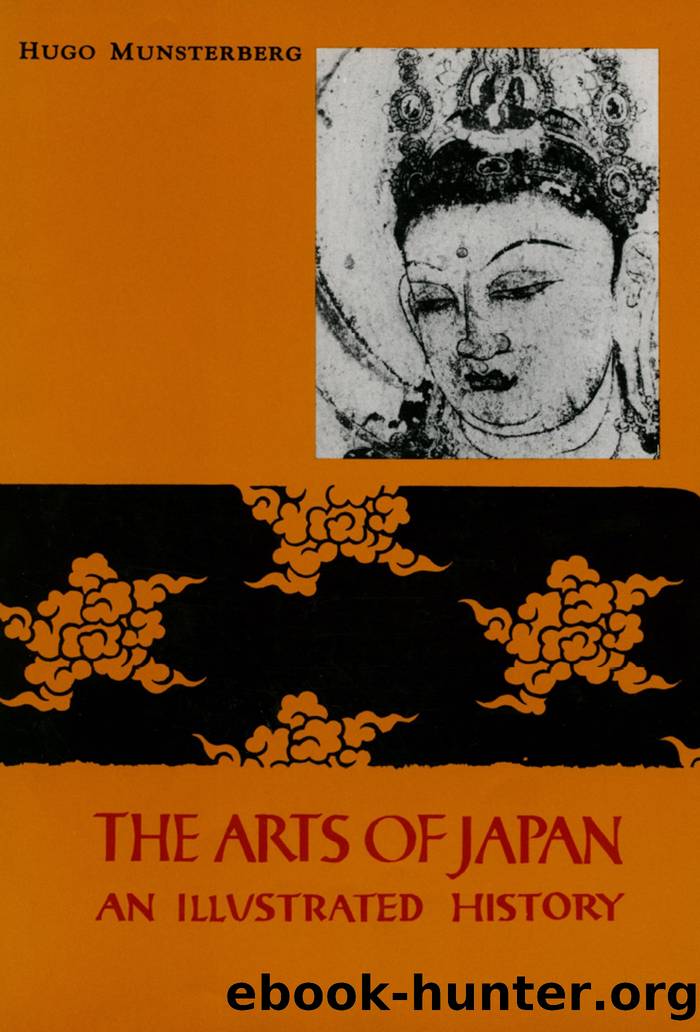The Arts of Japan by Hugo Munsterberg

Author:Hugo Munsterberg [Munsterberg, Hugo]
Language: eng
Format: epub
ISBN: 978-1-4629-0885-1
Published: 0101-01-01T00:00:00+00:00
THE ARCHITECTURE OF THE KAMAKURA PERIOD
The rule of the samurai affected architecture as profoundly as it did all other spheres of life, and the luxurious palaces and temples of the Heian period gave way to more modest buildings. With the well-to-do patrons gone, the Buddhist temples and Shinto shrines had to depend partly upon their own resources and partly upon popular subscription, and we are told that when Shunjobo ChÅgen undertook the task of rebuilding the great temple complex at TÅdai-ji, he had to travel all over Japan to raise the money for this enterprise. The tendency towards plainer and more unadorned structures is most clearly seen in the domestic architecture, and it is the simpler Kamakura dwelling which is the forerunner of the modern Japanese house. The renewed contact with China and the importation of Zen Buddhism also influenced architecture, and resulted in a style called Kara-yo, or Chinese style, because it had come from south China. This new manner with its emphasis on simplicity proved very popular, although the older Japanese style, the Wa-yo, continued as well.
It is surprising, especially when one thinks of the wealth of European examples which have survived from the thirteenth century, how few Kamakura structures actually remain. This is particularly true of the buildings in the Chinese style, of which hardly any have been preserved. The best of these, and the only Kamakura-period building left in Kamakura itself, is the Shanden, or Relic Hall, of the Engaku-ji (Plate 59). This temple, which once was one of the great centers of Zen Buddhism, was established in 1282 by HÅjÅ Tokimune. Characteristically enough, a Chinese monk, Tsu-yiian, or in Japanese, SÅgen, was invited to Japan to head the new establishment, and Japanese architects were sent to China to study Zen temple architecture. Unfortunately, of all the ancient buildings which made up the temple, only the Shanden is left. The exact date of its construction is not known, but it is believed that the hall, which is an outstanding example of the Kara-yo, was built in the last decade of the thirteenth century.
Despite its rather small dimensions (it is only thirty-five feet square and thirty-five feet high), the building makes an impression of solid strength. It stands on a stone platform, from which rise the slender pillars of the enclosed veranda. The most striking thing is the thatched double roof, consisting of a lower part which is quite shallow, and a huge upper part with beautifully curved eaves. The bracketing system is quite unique, with plain brackets under the eaves of the lower roof and very complex brackets in the space between the upper and lower roof. Other new features imported from China are the arched heads of the windows and doors, the delicate woodwork of the window lattices, and doors swinging on pivots. The building with its sober strength and beauty is an apt expression both of the Zen spiritual ideal and of the austerity of the life of the warrior class. No doubt many
Download
This site does not store any files on its server. We only index and link to content provided by other sites. Please contact the content providers to delete copyright contents if any and email us, we'll remove relevant links or contents immediately.
The Japanese by Christopher Harding(1085)
Watercolor With Me in the Forest by Dana Fox(753)
A Theory of Narrative Drawing by Simon Grennan(742)
The Story of the Scrolls by The Story of the Scrolls; the M(725)
Glittering Images: A Journey Through Art From Egypt to Star Wars by Camille Paglia(717)
Boris Johnson by Tom Bower(620)
This Is Modern Art by Kevin Coval(597)
The Art and Science of Drawing by Brent Eviston(588)
Frida Kahlo by Frida Kahlo & Hayden Herrera(584)
AP Art History by John B. Nici(575)
Banksy by Will Ellsworth-Jones(569)
War Paint by Woodhead Lindy(551)
Van Gogh by Gregory White Smith(547)
Draw More Furries by Jared Hodges(544)
About Looking by John Berger(543)
Scenes From a Revolution by Mark Harris(542)
Ecstasy by Eisner.;(535)
100 Greatest Country Artists by Hal Leonard Corp(523)
Young Rembrandt: A Biography by Onno Blom(514)
